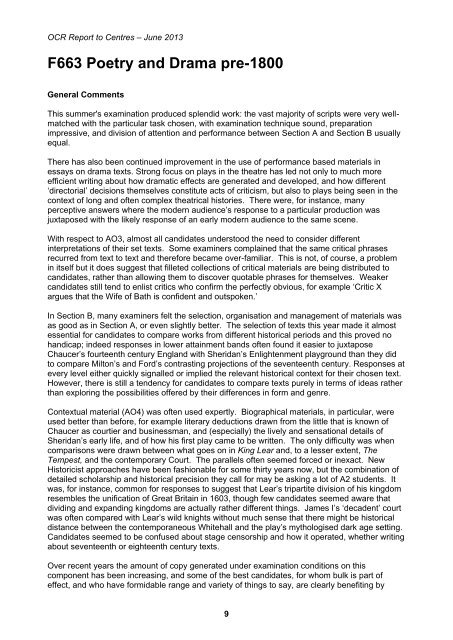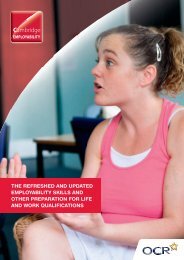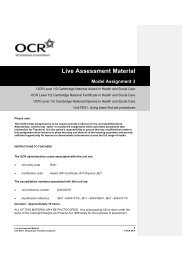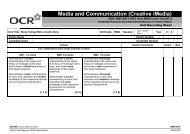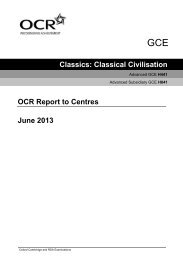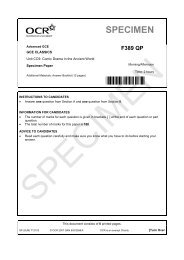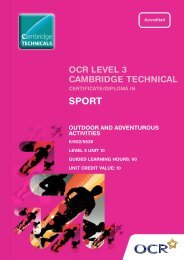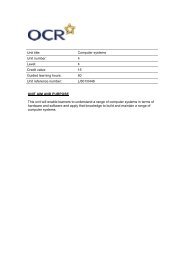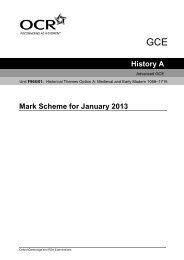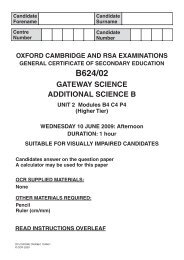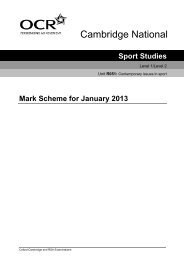Examiners' reports - June (PDF, 385KB) - OCR
Examiners' reports - June (PDF, 385KB) - OCR
Examiners' reports - June (PDF, 385KB) - OCR
You also want an ePaper? Increase the reach of your titles
YUMPU automatically turns print PDFs into web optimized ePapers that Google loves.
<strong>OCR</strong> Report to Centres – <strong>June</strong> 2013<br />
F663 Poetry and Drama pre-1800<br />
General Comments<br />
This summer's examination produced splendid work: the vast majority of scripts were very wellmatched<br />
with the particular task chosen, with examination technique sound, preparation<br />
impressive, and division of attention and performance between Section A and Section B usually<br />
equal.<br />
There has also been continued improvement in the use of performance based materials in<br />
essays on drama texts. Strong focus on plays in the theatre has led not only to much more<br />
efficient writing about how dramatic effects are generated and developed, and how different<br />
‘directorial’ decisions themselves constitute acts of criticism, but also to plays being seen in the<br />
context of long and often complex theatrical histories. There were, for instance, many<br />
perceptive answers where the modern audience’s response to a particular production was<br />
juxtaposed with the likely response of an early modern audience to the same scene.<br />
With respect to AO3, almost all candidates understood the need to consider different<br />
interpretations of their set texts. Some examiners complained that the same critical phrases<br />
recurred from text to text and therefore became over-familiar. This is not, of course, a problem<br />
in itself but it does suggest that filleted collections of critical materials are being distributed to<br />
candidates, rather than allowing them to discover quotable phrases for themselves. Weaker<br />
candidates still tend to enlist critics who confirm the perfectly obvious, for example ‘Critic X<br />
argues that the Wife of Bath is confident and outspoken.’<br />
In Section B, many examiners felt the selection, organisation and management of materials was<br />
as good as in Section A, or even slightly better. The selection of texts this year made it almost<br />
essential for candidates to compare works from different historical periods and this proved no<br />
handicap; indeed responses in lower attainment bands often found it easier to juxtapose<br />
Chaucer’s fourteenth century England with Sheridan’s Enlightenment playground than they did<br />
to compare Milton’s and Ford’s contrasting projections of the seventeenth century. Responses at<br />
every level either quickly signalled or implied the relevant historical context for their chosen text.<br />
However, there is still a tendency for candidates to compare texts purely in terms of ideas rather<br />
than exploring the possibilities offered by their differences in form and genre.<br />
Contextual material (AO4) was often used expertly. Biographical materials, in particular, were<br />
used better than before, for example literary deductions drawn from the little that is known of<br />
Chaucer as courtier and businessman, and (especially) the lively and sensational details of<br />
Sheridan’s early life, and of how his first play came to be written. The only difficulty was when<br />
comparisons were drawn between what goes on in King Lear and, to a lesser extent, The<br />
Tempest, and the contemporary Court. The parallels often seemed forced or inexact. New<br />
Historicist approaches have been fashionable for some thirty years now, but the combination of<br />
detailed scholarship and historical precision they call for may be asking a lot of A2 students. It<br />
was, for instance, common for responses to suggest that Lear’s tripartite division of his kingdom<br />
resembles the unification of Great Britain in 1603, though few candidates seemed aware that<br />
dividing and expanding kingdoms are actually rather different things. James I’s ‘decadent’ court<br />
was often compared with Lear’s wild knights without much sense that there might be historical<br />
distance between the contemporaneous Whitehall and the play’s mythologised dark age setting.<br />
Candidates seemed to be confused about stage censorship and how it operated, whether writing<br />
about seventeenth or eighteenth century texts.<br />
Over recent years the amount of copy generated under examination conditions on this<br />
component has been increasing, and some of the best candidates, for whom bulk is part of<br />
effect, and who have formidable range and variety of things to say, are clearly benefiting by<br />
9


